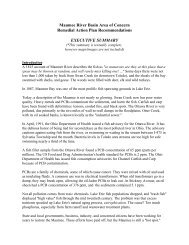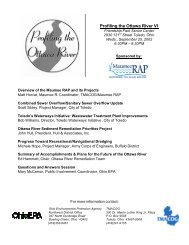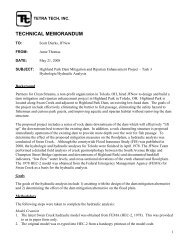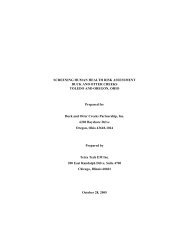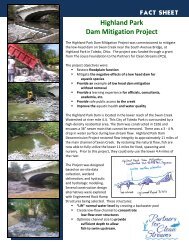Complete report - Partners for Clean Streams
Complete report - Partners for Clean Streams
Complete report - Partners for Clean Streams
You also want an ePaper? Increase the reach of your titles
YUMPU automatically turns print PDFs into web optimized ePapers that Google loves.
Site History:<br />
Northeast of Beatty Park and Jermain Park and bounded on the north by the Ottawa<br />
River and the south by S. Cove Blvd., this was a suspected paint waste disposal area<br />
<strong>for</strong> Willy’s Overland-Jeep, however there is little evidence to verify the existence of<br />
this site. (see - North Cove Landfill <strong>for</strong> more in<strong>for</strong>mation)<br />
Site Investigation (1992)<br />
This site was investigated as a part of the Ohio EPA Maumee Area of Concern<br />
Project Phase I Site Investigations and no further action was recommended.<br />
Lead Organization:<br />
Ohio EPA (funded in part by a grant from US EPA)<br />
Stickney Avenue Landfill (3900 Stickney Ave, Toledo)<br />
Site History:<br />
The Stickney Ave. Landfill is 55 acres. The Ottawa River is to the west and north with<br />
over 2500 feet of frontage. It was operated by the City of Toledo as a municipal,<br />
commercial and industrial waste landfill from 1958 to 1966. Waste was dumped into<br />
a <strong>for</strong>mer clay borrowing pit. Excessive soil erosion and leachate outbreaks existed<br />
along the entire landfill streambank perimeter. After the landfill stopped accepting<br />
waste is was covered with 0 to 3 feet of clay and was overgrown with vegetation.<br />
Prior to remediation the principle owners of Stickney were DaimlerChrysler (owning 33<br />
acres) and the City of Toledo (owning the remainder).<br />
Site Investigation (1984-1986)<br />
Sampling studies done in 1984 and 1986 by the Ohio EPA and the City of Toledo<br />
documented contaminant levels in the landfill soils and leachate high enough to<br />
warrant further action under the Superfund program.<br />
(1993)<br />
In February 1993, US EPA conducted a Removal Site Evaluation and found the<br />
contaminant levels did not meet the Removal Action Levels. There<strong>for</strong>e time-critical<br />
removal actions were deemed not necessary.<br />
In the spring of 1993 a Screening Site Inspection (SSI) by US EPA was done <strong>for</strong><br />
Stickney which documented the existence of as many as 40 leachate seeps along the<br />
river bank. Sampling of groundwater, leachate and soil substantiated the presence of<br />
many compounds at levels above background, including heptachlor, heavy metals<br />
and volatile and semi-volatile organic compounds.<br />
In June 1993 US EPA completed an ecological review of the available data on the<br />
Stickney Landfill and concluded that it contributed to the ecological risks of the Ottawa<br />
River and recommended steps be taken to stop the flow of leachate.<br />
In July 1993 the Ohio Department of Health (ODH) finished a Qualitative Health Risk<br />
Evaluation (QHRE) concluding that surface soils and leachate from Stickney<br />
contributed to the contamination of the river and wading poses an unacceptable risk to<br />
human health.<br />
(1993-1994)<br />
These sites were investigated as a part of the Ohio EPA Maumee Area of Concern<br />
Project Phase I site investigations and further investigation was recommended with<br />
the potential <strong>for</strong> remediation of the site.<br />
105<br />
Activities and Accomplishments<br />
Issue 2: Landfills, Dumps and<br />
in the Maumee Area of Concern Brownfield Sites



